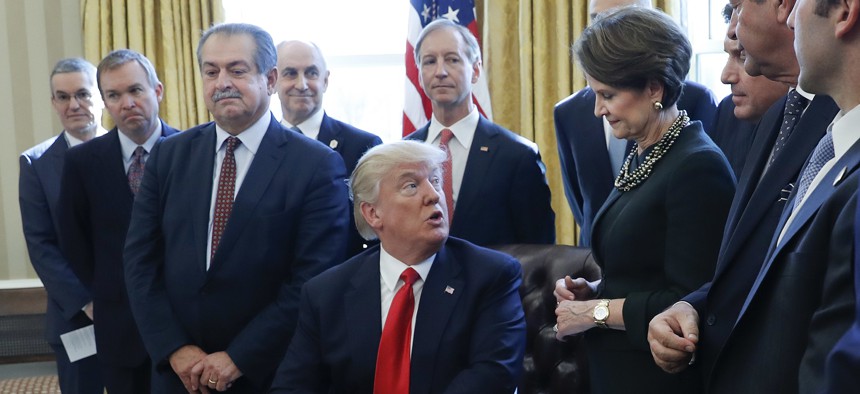
President Donald Trump looks over to Marillyn Hewson, Lockheed Martin chairman, CEO and president, before signing an executive order in the Oval Office on Feb. 24. AP Photo/Pablo Martinez Monsivais
Defense Industry Bulls Are Turning Bearish
Trump’s first hundred days in office have dampened execs’ hopes that he might bust through spending caps.
Last November, executives from America's largest defense companies lauded the election of Donald Trump, whom they believed might help end the legislative caps on Pentagon spending.
Five months later — nearly 100 days into Trump’s presidency — executives are tamping down those bullish military-spending expectations, and some are even re-upping the gloomy warnings of the final Obama years.
“We as a nation need to recognize these threats and provide our military leaders with relief from current budgetary constraints and allow them to address the challenges they face in defense of our country and our citizens,” Marillyn Hewson, the chairman, CEO and president of Lockheed Martin, said Tuesday during the firm’s quarterly earnings call. “We remain hopeful that progress will continue to be made in this area and upcoming legislation will include the increases necessary to continue to equip and maintain our fighting forces.”
As the nation’s largest defense firms report quarterly earning this week, a federal money crisis is looming. If Congress does not pass a budget by Friday, the government will cease non-essential operations. Lawmakers are expected to extend the temporary government spending measure called a continuing resolution, or CR, one week to allow more time for negotiations between the White House and Congressional Republicans and Democrats on a budget for the remainder of 2017.
Scott Donnelly, chairman, CEO and president of Textron, referred to “the CR and all the budgetary turmoil that’s going on” during his firm’s quarterly earnings call last week.
If Congress does not pass a full-year budget — by extending the continuing resolution for the remainder of the year — top generals have warned it would force them to curtail training and other expenditures. For companies, it prevents the Pentagon for launching new projects — curtailing others — or changing the quantities of arms and equipment buys.
For example, the Pentagon cannot increase production quantities of F-35 Joint Strike Fighters and Black Hawk helicopters.
That’s this year. For the next few years, the caps that have confounded defense hawks’ efforts to increases Pentagon spending remain in place. Despite a Republican president and GOP-controlled Congress, lawmakers cannot agree on how to pay for defense spending increases. Democrats want equal increases to domestic spending projects for any defense budget plus-ups. Within the GOP, defense hawks have looked to use the Pentagon’s unrestricted war budget as a way to circumvent the caps. But more deficit-minded Republicans, including Mick Mulvaney, Trump’s budget director and a former congressman, have opposed that.
Even though the 2017 budget for the Pentagon hasn’t been settled, the Trump administration is preparing to submit a 2018 budget in mid-May. The administration has already said that proposal will exceed the existing budget caps by $54 billion. If Congress passes that budget without repealing the caps, it would trigger sequestration, equal cuts to every spending account, something that last happened in 2013. Military leaders say they are still paying the price for having to reduce cut planned spending and curtail training.
Then there’s a separate $30 billion budget amendment, which called for more fighter jets, missiles and helicopters, that Trump proposed in March. The amendment has been largely DOA. However some of the items in that spending measure could find their way into a 2017 budget deal or the Pentagon’s 2018 spending plan.
“We are hopeful that these discussions result in an approved FY17 Defense Appropriations Act as we feel further lack of budget clarity would have longer-term consequences for our armed forces and our industry,” Hewson said. “We continue to urge our country’s leadership to reach an agreement.”




